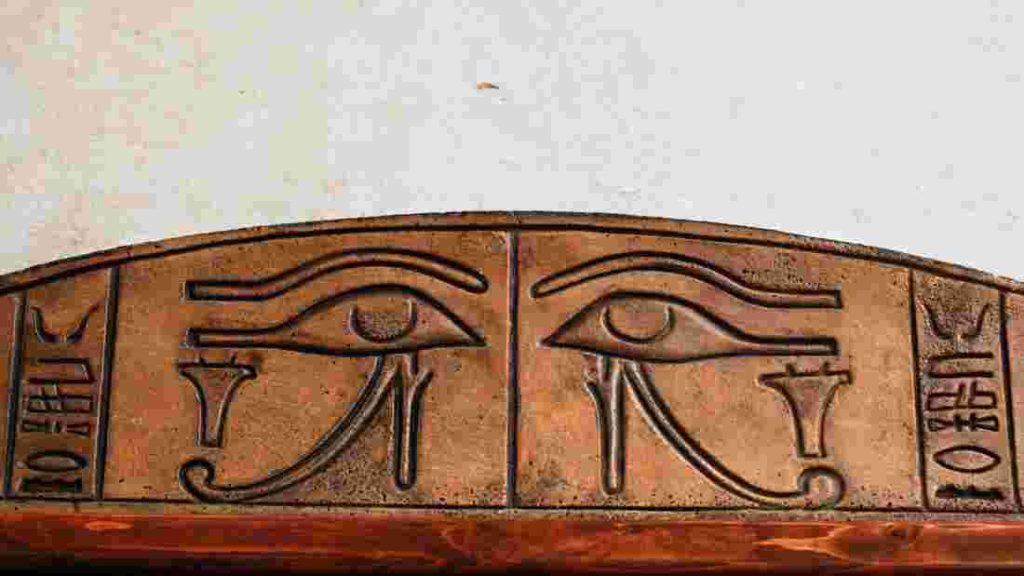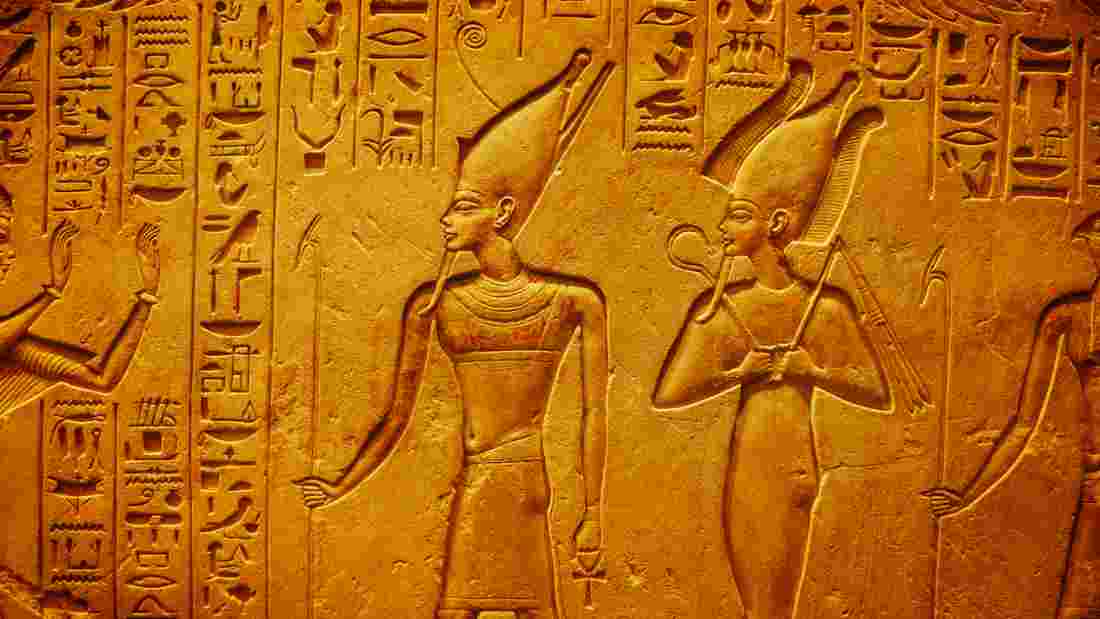Ancient Egyptian symbols associated with death, the afterlife and the gods were intricately carved into tombs, sarcophagi, and other artifacts to help guide souls safely through their journey into the afterlife after death occurred.
In this blog post, we’ll explore some of these ancient Egyptian symbols in order to gain a better understanding of how death was viewed in this culture.
The Ankh
The Ankh is an ancient Egyptian symbol that represents life, fertility, and immortality. It resembles a cross with a loop at the top and is often seen in hieroglyphs as well as carved into tomb walls or placed on sarcophagi.
In ancient Egyptian religion, the Ankh held significant spiritual meaning. It was believed that it represented “the key of life” because it could unlock the gates between heaven and earth for those who had passed away. Egyptians believed that after death, the soul would embark on a journey to the afterlife where they would be judged by Osiris, the god of the underworld. If found worthy, their soul would be led through a series of gates to reach paradise.
The Ankh played an important role in this journey as it was believed to have the power to unlock these gates and allow passage into paradise. The symbol was often depicted being held by gods and pharaohs in tomb paintings and other forms of art, emphasizing its importance in Egyptian culture.

The Scarab Beetle
The scarab beetle was one of the most sacred ancient Egyptian symbols, representing rebirth, renewal, and resurrection after death. The beetle was associated with Khepri, the god of the rising sun, who was believed to push the sun across the sky each day. According to Egyptian mythology, Khepri emerged from a scarab beetle that rolled the sun across the sky just as a dung beetle rolls its ball of dung.
The Egyptians believed that placing a scarab beetle on their chest would protect them in the afterlife and ensure their journey through the underworld. Scarabs were often carved out of precious stones or made from faience (a type of ceramic material) and were inscribed with spells or prayers to help guide the deceased on their journey.
In addition to being placed on mummies’ chests, scarabs were also used as amulets or charms for protection and good luck. They were often worn as jewellery by both men and women and could be found in various sizes and materials.
Today, scarabs continue to hold significance in Egyptian culture and are often used as a decorative motif in art and design. Their enduring popularity is a testament to their timeless symbolism and cultural importance.

The Eye Of Horus
The Eye of Horus is one of the most ancient and widely recognized symbols of Egypt. It is usually depicted as an eye surrounded by wings or feathers (often referred to as “the eye of protection”), and is also known as the Wedjat or the Eye of Ra.
According to Egyptian mythology, Horus was the god of the sky and had the head of a falcon. He was often depicted with two eyes, one representing the sun and the other representing the moon. The story goes that during a battle with his uncle Set, Horus lost his left eye. However, it was later restored by Thoth, the god of wisdom and writing.
The restored eye became known as the Eye of Horus and became a symbol of healing and protection. It was believed to have magical powers that could ward off evil spirits and protect against injury or illness. It also provided protection, strength and power in battle, and helped to guide souls safely through their journey into the afterlife after death had occurred. As such, it became a popular amulet worn by both men and women.
The Eye of Horus is also associated with Ra, the sun god who was considered to be one of the most important deities in ancient Egypt. Ra’s association with the eye further reinforced its connection to power and protection.
Today, people still use the Eye of Horus as a symbol for protection or as an amulet for good luck. Its enduring popularity is a testament to its timeless symbolism and cultural significance in Egyptian history.
It is usually depicted as an eye surrounded by wings or feathers (often referred to as “the eye of protection”).

The Pyramid
The pyramid shape is one of the most iconic symbols associated with ancient Egypt, and it is closely linked to death and the afterlife in this culture. Pyramids were monumental structures that were built to house tombs for important individuals, such as pharaohs and members of the nobility. These individuals believed that their bodies needed to be preserved so that they could live on in eternity after death.
The construction of pyramids was a massive undertaking that required a significant amount of resources, including labour, food, and building materials. The largest and most famous pyramids were built during the Old Kingdom period, between 2686 BC and 2181 BC. The Great Pyramid of Giza, which is one of the seven wonders of the ancient world, was built during this time.
Pyramids were not only used as tombs but were also believed to be portals between our world and the spiritual realm. Egyptians believed in an afterlife where souls could travel freely between both dimensions upon passing away from this life. The pyramid’s design represented this idea by pointing upwards towards the heavens while also providing a physical structure for the soul to return to after death.
The pyramid shape has become synonymous with ancient Egypt and continues to be an enduring symbol of its rich cultural heritage. Today, many people are fascinated by these structures and continue to visit them as a way of connecting with history and experiencing first hand one of humanity’s greatest achievements in architecture and engineering.

The Sphinx
The sphinx is a mythical creature that has captured the imagination of people for centuries. It is typically depicted as having the body of a lion and the head of a human or animal. In ancient Egypt, the sphinx was seen as a powerful guardian that protected temples and tombs.
The most famous sphinx in Egypt is located near the Great Pyramids of Giza. This massive structure stands over 20 meters tall and 73 meters long, making it one of the largest statues in the world. The Sphinx was carved out of a single block of limestone and depicts the face of a pharaoh, believed to be either Khafre or his father Khufu.
In ancient Egyptian mythology, the Sphinx was believed to have magical powers that could protect the dead in the afterlife. It was also associated with various gods, including Horus and Ra. The Sphinx’s role as a protector made it an important symbol in Egyptian culture, and its image can be found on many artifacts from this time period.
Despite its association with death and guardianship, the Sphinx also had an important spiritual significance in ancient Egypt. Its shape was thought to represent balance between opposing forces such as light and dark, good and evil, and life and death.
Today, people continue to be fascinated by the mystery surrounding this enigmatic creature. The Sphinx remains an enduring symbol of ancient Egypt’s rich cultural heritage and continues to inspire awe in visitors from around the world who marvel at its impressive size and intricate design.
The Lotus Flower
The lotus flower was a significant symbol in ancient Egyptian culture and was often associated with rebirth and regeneration. The Egyptians believed that the lotus flower emerged each morning from the underworld, which represented the cycle of life, death, and rebirth.
The lotus flower’s symbolism is rooted in its physical characteristics. It grows in muddy waters but rises above the surface to bloom into a beautiful and fragrant flower. This process was seen as a metaphor for the journey of the soul through life and death.
Lotus flowers were often depicted in tomb paintings and hieroglyphics, where they were used to symbolize resurrection and new beginnings. They were also used as offerings to the gods during religious ceremonies.
In addition to its spiritual significance, the lotus flower had practical uses as well. Its seeds were used for food, while its stems and leaves were used to make medicine. The plant’s oil was also used for perfumes and cosmetics.
The Feather of Ma’at
Ma’at was one of the most important goddesses in ancient Egyptian mythology. She was the goddess of truth, justice, and balance, and her name meant “that which is straight.” Ma’at was often depicted as a woman wearing a feather on her head, which became one of the most important Egyptian symbols associated with death, truth and justice in ancient Egypt.
In Egyptian belief, the afterlife was a continuation of life on earth. The soul would travel to the underworld where it would be judged by Osiris, the god of the dead. Ma’at’s feather was used as a symbol of truth and justice during this judgment process. The heart of the deceased would be weighed against Ma’at’s feather to determine if they were worthy of entering the afterlife.
The weighing of the heart ceremony was a crucial part of ancient Egyptian funerary rituals. The feather represented Ma’at’s principles of truth, justice, and balance. If the heart weighed more than the feather, it indicated that the person had lived an unjust life and would not be allowed to enter into eternal paradise.
Feathers were also used as actual weighing scales during this ceremony. They were placed on one side of a scale while the heart was placed on the other side to determine its weight. This practice reinforced Ma’at’s importance as a guiding principle for moral behavior in life.
Final Thoughts on the Ancient Egyptian Symbols of Death
In conclusion, the ancient Egyptians had a complex and multifaceted relationship with death, which is reflected in their use of powerful symbols to represent the transition from life to the afterlife. The Ankh, Scarab Beetle, and Eye of Horus are just a few examples of the many Egyptian symbols that were used to convey the idea of death as a transformative experience.
For the Egyptians, death was not simply an end but also a new beginning. It was a journey into the afterlife where one could be reborn and achieve eternal life. This belief in resurrection and renewal is evident in many of their funerary practices, including mummification, tomb paintings, and hieroglyphics.
These Egyptian symbols remind us that in this culture death was not just a physical experience but also an emotional and spiritual one. They illustrate how deeply ingrained beliefs about rebirth, fertility, and eternal life were in Egyptian culture.
For Further Reading
Large Stockpile of Embalming Equipment discovered in Abusir
Mummification: Why did the Ancient Egyptians embalm their dead?
Saba Mahmood – a strong voice in the anthropology of religion and post-colonialism
Unravelling the Mysteries of Ancient Egyptian Symbols of Death – Anthropology Review
The Wrath of Montu – The Mythology of the Egyptian War God
Exploring the Egyptian Middle Kingdom – A Historical Overview
Examining the Rich Hues of Ancient Egyptian Paint
Ancient Egyptian Temples: Spiritual Centers of the Nile Civilization
The Symbolism and Significance of Ancient Egyptian Jewelry
The Pantheon of Ancient Egyptian Gods – A Comprehensive Guide
Temple of Seti I: An Architectural Marvel in the Ancient City of Abydos
Disclosure: Please note that some of the links in this post are affiliate links. When you use one of my affiliate links, the company compensates me. At no additional cost to you, I’ll earn a commission, which helps me run this blog and keep my in-depth content free of charge for all my readers.


